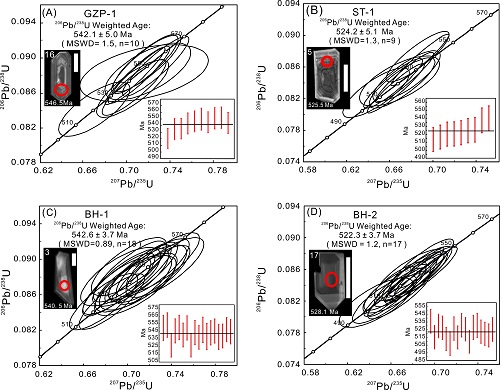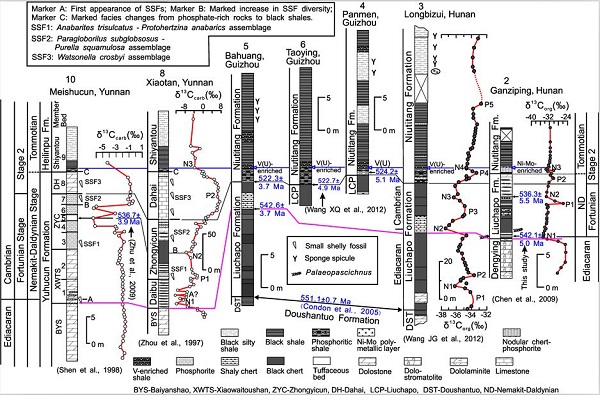New U–Pb zircon ages of the Ediacaran–Cambrian boundaryUpdate time:06 08, 2015
The Ediacaran–Cambrian (E–C) transition is a critical interval marking one of the most drastic biological, oceanic and geochemical co-evolutions in geological history. The E–C boundary is defined by the first appearance datum (FAD) of trace fossil Trichophycus pedum co-occurring with sparse small shelly fossils (SSFs) at the siliciclastic-dominated Fortune Head GSSP section, SE Newfoundland, Canada. Due to the absence of suitable material, however, it cannot be dated radiometrically. In carbonate successions, a horizon marking an abrupt extinction of Ediacaran fauna (Cloudina and Namacalathus) and FAD of SSFs coincident with a large, short-lived negative δ13C excursion is also considered to be the E-C boundary, which has been dated now with a high-precision U-Pb age of 542.0±0.3 Ma and further calibrated to 541.00 ± 0.13 Ma in Oman. In South China, the E–C successions were well developed in a wide spectrum of depositional environments in which the famous “Chengjiang Biota” – the first window of “Cambrian Explosion” – was exclusively preserved there. However, the E-C boundary in South China has not been dated radiometrically, which largely limits our efforts to explore and understand the co-evolution of this great bioradiation and ambient environmental processes. Professor Daizhao Chen from the Institute of Geology and Geophysics, CAS, and his team collected multiple tuffaceous layers from E–C boundary strata (Dengying/Liuchapo and Niutitang formations) in slope–basin sections in western Hunan and eastern Guizhou, South China, and obtained two new sets of SIMS U–Pb zircon ages (Figure 1). Two weighted-mean U–Pb ages of 542.1 ± 5.0 Ma and 542.6 ± 3.7 Ma at the base and mid-upper part of the Liuchapo Formation deposited in slope and basinal settings, respectively, provide the first direct age constraint for the E–C boundary in South China. This placement is also consistent with a strong negative δ13C excursion and concomitant rapid large-scale transgression event seen globally. Another set of two U–Pb ages of 524.2 ± 5.1 Ma and 522.3 ± 3.7 Ma from the base of the overlying Niutitang Formation indicates that this widespread organic-rich unit in South China was deposited about 20 Ma later than the onset of the Cambrian Period, which corresponds to the late N-D (or Stage 2) or the early Tommotian Stage. This reconciles the occurrence of the second post-Ediacaran positive δ13C excursion in the base of the Niutitang Formation. Consequently, these new age sets, along with biozonation and isotope chemostratigraphy, allow for a better calibration of the time framework of the basal Cambrian (Figure 2), which facilitates a better understanding of the co-evolution of life and environments in this critical time interval.
Figure 1: U–Pb concordia diagrams of zircon analyses from samples GZP-1 (A), ST-1 (B), BH-1 (C) and BH-2 (D).
Figure 2: Stratigraphic correlation of the E–C boundary successions between shallow- and deep-water settings in South China constrained by both U–Pb isotope ages and carbon isotope data.
|
Contact
Related Articles
Reference
|
-
SIMSSecondary Ion Mass Spectrometer Laboratory
-
MC-ICPMSMultiple-collector ICPMS Laboratory
-
EM & TEMElectron Microprobe and Transmission Electron Microscope Laboratory
-
SISolid Isotope Laboratory
-
StIStable Isotope Laboratory
-
RMPARock-Mineral Preparation and Analysis
-
AAH40Ar/39Ar & (U-Th)/He Laboratory
-
EMLElectron Microscopy Laboratory
-
USCLUranium Series Chronology Laboratory
-
SASeismic Array Laboratory
-
SEELaboratory of Space Environment Exploration Laboratory
-
PGPaleomagnetism and Geochronology Laboratory
-
BioMNSFrance-China Bio-mineralization and Nano-structure Laboratory

 Print
Print Close
Close

